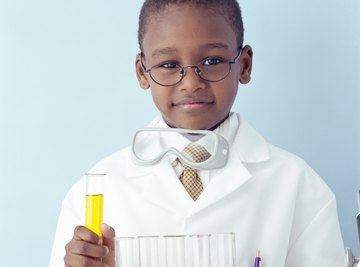
Experiments are interesting and they are more fun when you use real laboratory equipment like test tubes. You can use either plastic or glass test tubes, but the plastic ones are generally safer. Before you attempt any experiments, check with a parent or other adult. Always wear safety glasses, follow the instructions and clean up when you’re finished. Consider having a “Mad Scientist” party with your friends and perform test tube science experiments in your “lab.”
Make Hydrogen Bubbles
You need a test tube, iron nail, sandpaper, vinegar, ruler and a test tube rack. Add two inches of vinegar to the test tube. Place the tube in the test tube rack. Alternatively, use a mound of modeling clay with a hole in the middle to accommodate the test tube. Sand the pointed end of the nail to obtain a clean surface. Put the nail, pointed side down, in the test tube and allow it to sit for several minutes. The bubbles you will see forming near the nail are hydrogen bubbles.
Rainbow in a Test Tube
Prepare the following solutions, one per glass with its own eye dropper: 100 mL water mixed with red food coloring; 15 mL water with 5 mL ethyl alcohol and yellow dye; 10 mL water with 10 mL ethyl alcohol and green dye; 5 mL water with 15 mL ethyl alcohol and blue dye; and 20 mL ethyl alcohol, either clear or dyed purple. Drop five drops of a solution into a 10 mm. test tube. Add five drops of another solution, letting the drops run down the inside of the tube. Find the order of density of all five solutions. If an upper layer is denser than the layer beneath it, it will mix with the lower layer or have an indistinct border. Rinse the test tube and start again. Through a process of elimination, you’ll find the right order for a beautiful rainbow.
Cabbage Indicator
Chop some red cabbage into small pieces, put it into a microwave-safe bowl, cover the cabbage with water and microwave it until the water boils and is dark purple. This will take several minutes, but don’t overdo it because the pigment will disappear. Let the container cool. Pour the purple water through a strainer into another bowl. Discard the cabbage. The test whether a substance, such as orange juice, milk or laundry detergent, is an acid or base, pour an inch of indicator into a test tube and add three drops of the test substance. Acids turn the indicator pink.
Inflate a Balloon with a Test Tube
Put one teaspoon baking soda into a medium-size balloon using a funnel. Put 2 ounces of vinegar into the test tube. Stretch the neck of the balloon over the test tube opening, leaving the remainder of the balloon flopped over the side so the baking soda stays inside. When you’re ready to inflate the balloon, straighten the balloon so the baking soda drops inside the test tube. When the two substances mix, they produce oxygen and the balloon inflates.
References
About the Author
Annette Strauch has been a writer for more than 30 years. She has been a radio news journalist and announcer, movie reviewer for Family Movie Reviews Online, chiropractic assistant and medical writer. Strauch holds a Master of Arts in speech/broadcast journalism from Bob Jones University, where she also served on the faculty of the radio/TV department.
Photo Credits
Digital Vision/Digital Vision/Getty Images
